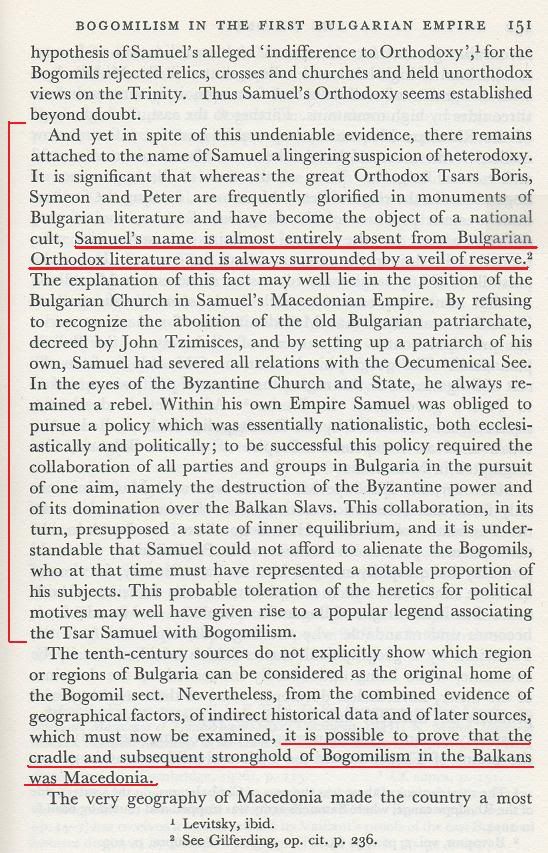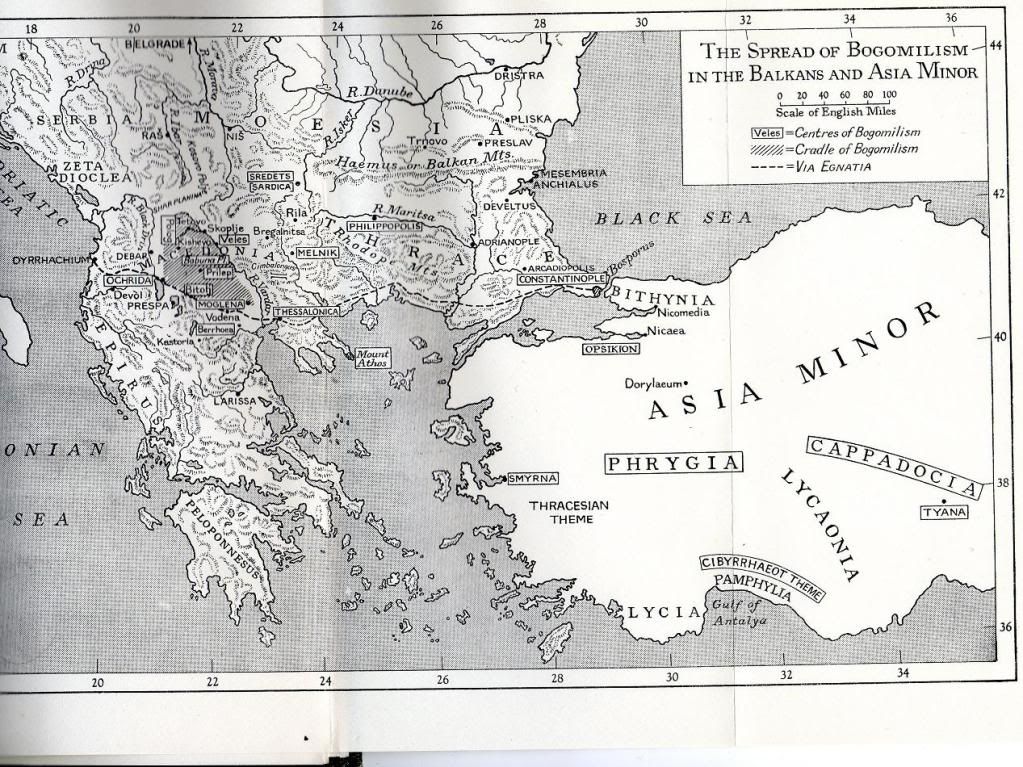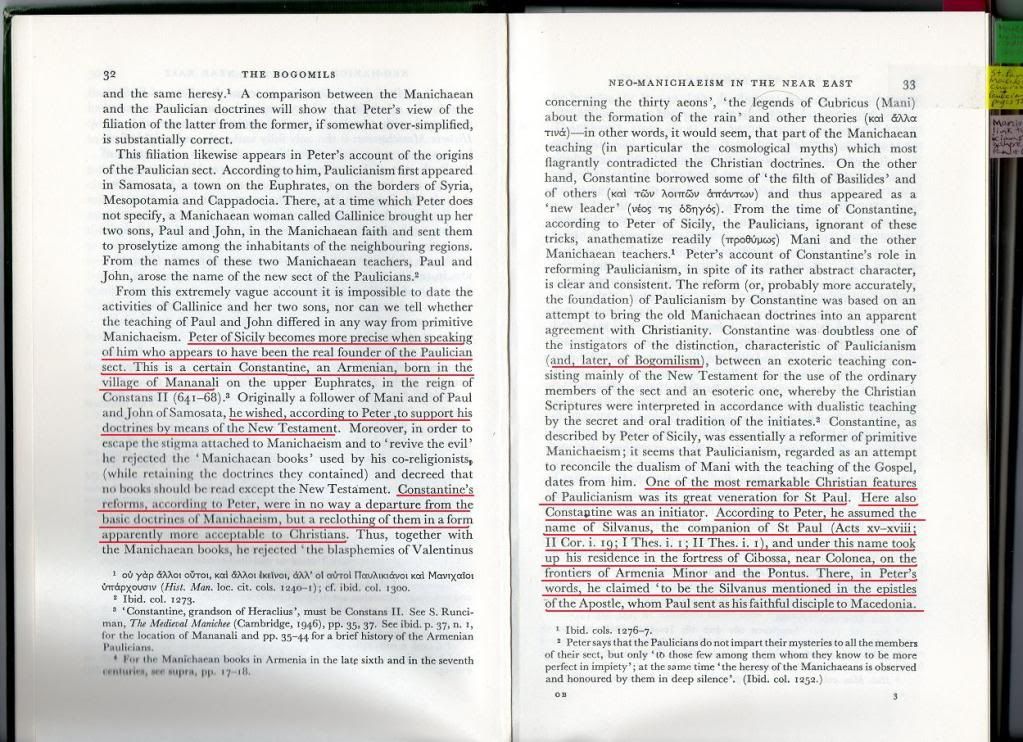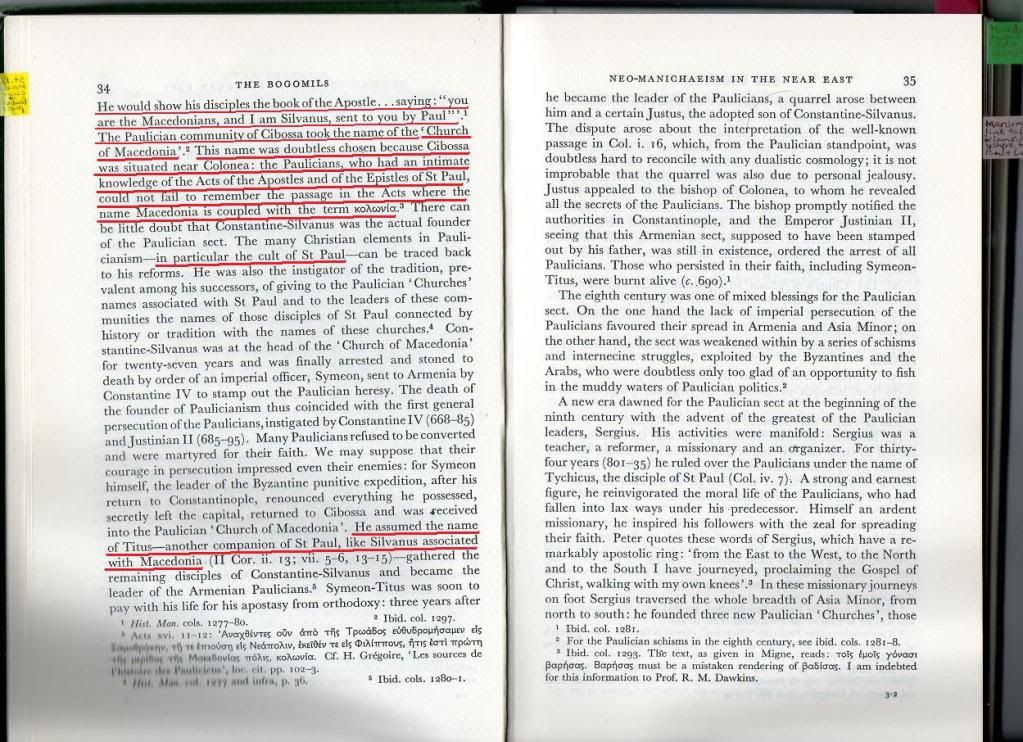The members are referred to as Babuni in several documents. Toponyms which include the river Babuna, the mountain Babuna, the Bogomila Waterfall and village Bogomila, all in the region of Azot today in central Republic of Macedonia, suggests that the movement was very active in the region.[6][7]
Some historians claim that tzar Samuil and in particular his son Gavril Radomir supported the movement. The core of Samuil's empire corresponds to the region where the Bogomils were most active. Most probably, as Samuil revolted against the Byzantine Empire, he relied on the popular support of the movement. There are no sources of Bogomil persecution during his reign (976 - 1014).[6]
The Bogomils spread westwards and settled first in Serbia; but at the end of the 12th century Stefan Nemanja, Great Župan of Serbia, expelled them from the country. Large numbers took refuge in Bosnia, where they were known under the name of Patarenes or Patareni. There, they were also brought into connection with the indigenous Bosnian Church, which was also considered heretical by the Pope and Byzantines, but was not actually Bogomil in nature.
6.^ a b Obolensky, Dimitry (1948). The Bogomils: A study in Balkan Neo-Manicheism. Cambridge University Press. ISBN 0-521-58262-8.
7.^ Loos, Milan (1974). Dualist heresy in the Middle Ages. Czechoslovak Academy of Sciences.
Some historians claim that tzar Samuil and in particular his son Gavril Radomir supported the movement. The core of Samuil's empire corresponds to the region where the Bogomils were most active. Most probably, as Samuil revolted against the Byzantine Empire, he relied on the popular support of the movement. There are no sources of Bogomil persecution during his reign (976 - 1014).[6]
The Bogomils spread westwards and settled first in Serbia; but at the end of the 12th century Stefan Nemanja, Great Župan of Serbia, expelled them from the country. Large numbers took refuge in Bosnia, where they were known under the name of Patarenes or Patareni. There, they were also brought into connection with the indigenous Bosnian Church, which was also considered heretical by the Pope and Byzantines, but was not actually Bogomil in nature.
6.^ a b Obolensky, Dimitry (1948). The Bogomils: A study in Balkan Neo-Manicheism. Cambridge University Press. ISBN 0-521-58262-8.
7.^ Loos, Milan (1974). Dualist heresy in the Middle Ages. Czechoslovak Academy of Sciences.
Manichaeism
In the third century AD, before Christianity became the official religion of the Roman empire, a Persian named Many (Latin Manes, Manicheus), gathered Christian Gnostic and Buddhist elements and combined them with the Zoroastrian teaching.
He gave a simple explanation for where evil in the world comes from, preaching new dualistic religion. For this he was condemned by the Persian magi (those wise men - actually Zoroastrian priests - mentioned in the Bible). Mani was executed for his heresy in 276 AD.
By the second half of the seventh century a Gnostic sect named Pavlikianis was active in Armenia incorporating elements of Mani's teachings. This sect was seen as a threat to the state authorities. Tzars Constantine V Kopronim (741-775) and Ivan Cimiskes (969-976) forceably removed them to Thrace and Macedonia.
Bogomils
The Bogomils or Bogumils appeared in Bulgaria in the middle of the 10th century in the time of Bulgarian Tzar Peter (927-969). It seems evident, though there is no formal proof, that the Dualist beliefs of the Bogomils was a continuation of the Pavlikiani teaching from nearby Macedonia.
The first known written information about this heresy appears in the epistle of Patriarch Teofilact to Tsar Peter. He explains to the Tsar that this heresy is the "Pavlikian heresy mixed with Manicheanism".
More information is to be found in the apologetic tractate of the presbyter Cosma, "Speech on Heresy" created around 972. Cosma blames a priest called Bogomil for spreading this new teaching across Bulgaria - a teaching that opposes the teaching of the orthodox Christian church - that there is only one god.
Bogomil taught that there are two gods - one the god of good, and the other the god of evil. The god of evil created whole material world, including human beings. By his will exist all the visible things: the earth itself, animals, churches, crosses. Some of the Bogomils thought that the evil god, Satan, was God's younger son, next to Christ, the older brother. Others thought that he was not God's son but an angel that seceded from the ranks.
Cosma, further on in his tractate, says that the Bogomils were attacking the Church establishment, especially the clergy and bishops, and that they rejected Old Testament along with the books of the church fathers, and the [then new] cult of the Virgin Mary's along with the cults of other saints, all the other Church literature and all the prayers except the Lord's Prayer "Our father…".
Further, they did not respect icons, nor the cross, and they did not accept church buildings as the house of God. They gathered in their houses to pray and confess to each other.
They had critical attitude towards the governments, the state establishment, and the rules of society. They were alleged to incite their followers to rebel against the authorities, deterring slaves from working for their masters. They were attacking the established Church hierarchy and the nobility, teaching that those who worked for the tsar were repulsive to God.
They preached poverty and were critical of the rich. Cosma describes the heretics as quiet people, pale from fasting, dressed in modest clothes. But according to Cosma, this is only a ploy, and in fact they are rapacious, seeking out people with a simple spirit, and talking to them about the salvation of their souls.
The popularity of the dualistic heresy may be an expression of rebellion towards the hierarchy of the Orthodox Christian Church - a Church that like it's offshoot, the Roman Catholic Church, uses the idea of a god to keep its followers in obedience. It may also be an expression of rebellion against government institutions that lean on the Christian Church, using it to bolster and endorse their power. The appearance of the Bogomils in Macedonia and Bulgaria occurs at a time when local people felt oppressed by Byzantium, after the death of the Tsar Simeon, in the time of Tsar Peter. Ideologically, this Gnostic teaching was opposed to the Byzantine conquerors, against the pliable local nobility and against the hierarchy of the Orthodox Christian Church. (According to Cosma's notes the Orthodox Christian Church was itself utterly corrupt).
In the third century AD, before Christianity became the official religion of the Roman empire, a Persian named Many (Latin Manes, Manicheus), gathered Christian Gnostic and Buddhist elements and combined them with the Zoroastrian teaching.
He gave a simple explanation for where evil in the world comes from, preaching new dualistic religion. For this he was condemned by the Persian magi (those wise men - actually Zoroastrian priests - mentioned in the Bible). Mani was executed for his heresy in 276 AD.
By the second half of the seventh century a Gnostic sect named Pavlikianis was active in Armenia incorporating elements of Mani's teachings. This sect was seen as a threat to the state authorities. Tzars Constantine V Kopronim (741-775) and Ivan Cimiskes (969-976) forceably removed them to Thrace and Macedonia.
Bogomils
The Bogomils or Bogumils appeared in Bulgaria in the middle of the 10th century in the time of Bulgarian Tzar Peter (927-969). It seems evident, though there is no formal proof, that the Dualist beliefs of the Bogomils was a continuation of the Pavlikiani teaching from nearby Macedonia.
The first known written information about this heresy appears in the epistle of Patriarch Teofilact to Tsar Peter. He explains to the Tsar that this heresy is the "Pavlikian heresy mixed with Manicheanism".
More information is to be found in the apologetic tractate of the presbyter Cosma, "Speech on Heresy" created around 972. Cosma blames a priest called Bogomil for spreading this new teaching across Bulgaria - a teaching that opposes the teaching of the orthodox Christian church - that there is only one god.
Bogomil taught that there are two gods - one the god of good, and the other the god of evil. The god of evil created whole material world, including human beings. By his will exist all the visible things: the earth itself, animals, churches, crosses. Some of the Bogomils thought that the evil god, Satan, was God's younger son, next to Christ, the older brother. Others thought that he was not God's son but an angel that seceded from the ranks.
Cosma, further on in his tractate, says that the Bogomils were attacking the Church establishment, especially the clergy and bishops, and that they rejected Old Testament along with the books of the church fathers, and the [then new] cult of the Virgin Mary's along with the cults of other saints, all the other Church literature and all the prayers except the Lord's Prayer "Our father…".
Further, they did not respect icons, nor the cross, and they did not accept church buildings as the house of God. They gathered in their houses to pray and confess to each other.
They had critical attitude towards the governments, the state establishment, and the rules of society. They were alleged to incite their followers to rebel against the authorities, deterring slaves from working for their masters. They were attacking the established Church hierarchy and the nobility, teaching that those who worked for the tsar were repulsive to God.
They preached poverty and were critical of the rich. Cosma describes the heretics as quiet people, pale from fasting, dressed in modest clothes. But according to Cosma, this is only a ploy, and in fact they are rapacious, seeking out people with a simple spirit, and talking to them about the salvation of their souls.
The popularity of the dualistic heresy may be an expression of rebellion towards the hierarchy of the Orthodox Christian Church - a Church that like it's offshoot, the Roman Catholic Church, uses the idea of a god to keep its followers in obedience. It may also be an expression of rebellion against government institutions that lean on the Christian Church, using it to bolster and endorse their power. The appearance of the Bogomils in Macedonia and Bulgaria occurs at a time when local people felt oppressed by Byzantium, after the death of the Tsar Simeon, in the time of Tsar Peter. Ideologically, this Gnostic teaching was opposed to the Byzantine conquerors, against the pliable local nobility and against the hierarchy of the Orthodox Christian Church. (According to Cosma's notes the Orthodox Christian Church was itself utterly corrupt).
- babunes (characteristic name in Serbia, coming from the name of the mountain Babuna in Macedonia)










Leave a comment: